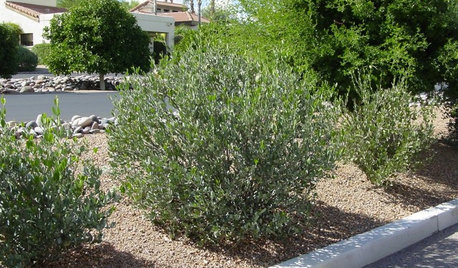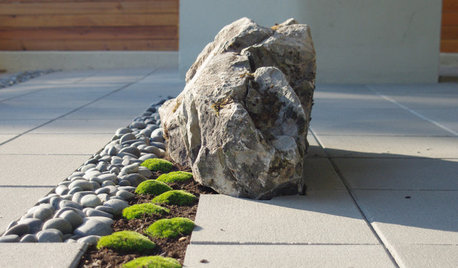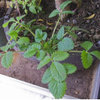Organic vs. Round-up regarding surrounding desired plants
chueh
14 years ago
Featured Answer
Sort by:Oldest
Comments (37)
chueh
14 years agolast modified: 9 years agoRelated Discussions
Using Round-Up around Vegetable Garden
Comments (10)Lots of good tips already in this thread. i find the bucket trick works well. You can also use an old piece of cardboard as a shield. i like the pieces they use to separate layers of product on the pallets at Costco, cut in half. Just lay them in pathways when you're done (and they are dry). Round-up is effective at even lower rates than the label suggests, especially on young and/or nonwoody plants. Using a little sticker/spreader (surfactant) really increases the efficacy even at lower concentrations. Works best on plants that are actively growing so ideally you could spray on a calm sunny day right after a nice rain. Read labels-if glycophosate is not branded Round-up it's a little cheaper....See MoreChalk one up for growing organic
Comments (80)@olpea: Oh, my goodness, there are a bunch of pages I missed! I was in worse shape than I even realised, yesterday. Still pretty bad today. @Harvestman: >your desire to convince us and/or yourself that organic production is becoming comparably as cost affective as conventional Oh, dear, is that what you think I think?! I sure have been doing a terrible job of communicating, then. I was just looking for explanations of the facts on the ground at my local markets: OG stuff does not cost more than conventional across the board. Why is that? As for what the true costs are per acre, I don't really know if I am qualified to speculate. Certainly I am not saying that I know! I will go ahead and speculate, just so you will not have to imagine what I think ;). I think that, in most cases, people who use conventional methods do so because it is lower cost /to them/. When we factor in national costs such as military defense of oil, farm subsidies, health care and pollution... I don't know. By that I mean, I really have no opinion. I think that for some crops in some ecosystems, there may well be no personal-cost benefit to non organic methods, and people who use them might just do so because they don't know that. I certainly do not think this is the case for all crops everywhere! To me, that idea is absurd. I am a little befuddled that you would pin it on me, but I guess I am a stranger to you....See MoreNutritional value studies -- OG vs Non-organic
Comments (17)Excellent link Wayne, as stated previously, experimental design is CRUCIAL and your link goes into great detail illustrating the point. It is very unfortunate that with all the ability to disseminate information these days, so much mis-information is added, it confuses people and makes finding the accurate, true information that much harder to glean. Your link also shows how much effort is required to set up a good field experiment before one even proceeds to the field. There is a great deal of effort that goes into any field experiment (hopefully) before the design is finalized including extensive literature research. When reading anyone's research, it is critical to scrutinize, among other sections, the conclusions section to see if it holds water....See MoreNew Report about dangers of Round UP
Comments (151)Henry, I read that study and the findings and it suggests that the manner of application if done improperly leads to problems due to the fact that the product penetrates the skin. Let us say for the sake of argument you do everything "correctly" and apply without skin penetration, what about the residues and product that do not break down or wash off the the veggie or the corn or soy? I understand from what I read that round up resistant GMO's were developed to allow farmers to use even more of the glyophosate so it follows that if it persists in the soil and environment and on the vegatative material in greater amounts. Okay, so now in the GMO situation they use even more of it...the studies I have read that come from different sources seems to suggest that glyophosate does not break down in soil as believed and if it is turning up in breast milk doesn't that mean we are digesting it? and that it is persistant in the environment? I am not singling out any of the particular ingredients but it may just be what is in the formulation. (I have a link from an Autism site regarding the persistance of pesticides and herbicides in humans, breast milk and umbilical cords etc... one of these studies listed my neighbor's mother in Seattle was involved with in San Francisco due to the prevalence of breast cancer in the area. - her mom died and they linked the levels of breast cancer to mercury from fish, and pesticides.) Wouldn't this support what the French research suggests? It is not just the application but the actual ingestion via skin penetration or the food? My friend whose child has autism says that there are so many controversies regarding this issue it is hard to single out one single cause except that it appears to be an environmental related issue and possibly a gene connection where some individuals are more sensitive to pesticides and how they penetrate cells. Unfortunately it is too late for her child. For the most part I have not seen most people use gloves to use pesticides, in the cases in Argentina it was "arial spraying, and "combinations" of deadly pesticides with the glyphosate where the birth defects and cancer were turning up. I poisoned myself in my 20's when I did not use gloves, and did not understand the significance of the label and the warnings. Most people are not educated about these labels, in fact I was told that "round up was perfectly safe" by the garden center that sold it to me. It is all so disturbing. I am going to interview the organic farmer I met and ask him about his process. He was very clear that he went organic because "it was the right thing to do, and teased his friend, the other farmer about not being a moral person...in jest...Farmers, especially small family farms live in a different world than the home, or urban gardener. If we the consumers are misled it is easy to see how farmers would be misled as well....See Morehenry_kuska
14 years agolast modified: 9 years agoKimmsr
14 years agolast modified: 9 years agomike9
14 years agolast modified: 9 years agoJAYK
14 years agolast modified: 9 years agohortster
14 years agolast modified: 9 years agohenry_kuska
14 years agolast modified: 9 years agoJAYK
14 years agolast modified: 9 years agohenry_kuska
14 years agolast modified: 9 years agoJAYK
14 years agolast modified: 9 years agohenry_kuska
14 years agolast modified: 9 years agohenry_kuska
14 years agolast modified: 9 years agoJAYK
14 years agolast modified: 9 years agohenry_kuska
14 years agolast modified: 9 years agoJAYK
14 years agolast modified: 9 years agohenry_kuska
14 years agolast modified: 9 years agohenry_kuska
14 years agolast modified: 9 years agoJAYK
14 years agolast modified: 9 years agohenry_kuska
14 years agolast modified: 9 years agoJAYK
14 years agolast modified: 9 years agohenry_kuska
14 years agolast modified: 9 years agohenry_kuska
14 years agolast modified: 9 years agohenry_kuska
14 years agolast modified: 9 years agohenry_kuska
14 years agolast modified: 9 years agoJAYK
14 years agolast modified: 9 years agohenry_kuska
14 years agolast modified: 9 years agoJAYK
14 years agolast modified: 9 years agohenry_kuska
14 years agolast modified: 9 years agohenry_kuska
14 years agolast modified: 9 years agoJAYK
14 years agolast modified: 9 years agohenry_kuska
14 years agolast modified: 9 years agoJAYK
14 years agolast modified: 9 years agohenry_kuska
14 years agolast modified: 9 years agoJAYK
14 years agolast modified: 9 years agohenry_kuska
14 years agolast modified: 9 years agohenry_kuska
14 years agolast modified: 9 years ago
Related Stories

BOOKSCan Tidying Up Result in Life-Changing Magic?
Organizing phenom Marie Kondo promises big results — if you embrace enormous changes and tough choices
Full Story
LANDSCAPE DESIGNSoak It Up: How to Manage Stormwater in Your Landscape
Permeable paving, gravel beds and planted areas in your yard can absorb and cleanse stormwater runoff. Here's how it works
Full Story
GARDENING GUIDES8 Native Shrubs for Year-Round Bird Feeding
It’s not just about berries. These plants provide insects for birds and seasonal interest for gardeners
Full Story
GARDENING GUIDESGreat Design Plant: Simmondsia Chinensis
Jojoba shrugs off hot, reflected desert heat while making surrounding plants stand out
Full Story
ORGANIZING‘Tidying Up’ Author Marie Kondo Tells How to ‘Spark Joy’ at Home
A new book from the author of ‘The Life-Changing Magic of Tidying Up’ delves deeper into her KonMari Method of decluttering and organizing
Full Story
FEEL-GOOD HOME10-Minute Updates to Freshen Up Your Home
When life is hectic and time is limited, these speedy styling tricks can make a big difference
Full Story
GARDENING GUIDESOh, Deer! 10 Native Flowers That Stand Up to the Herds
Keeping a garden amid hungry deer can be hard, but these plants should fare well
Full Story
LANDSCAPE DESIGNDare to Mix Things Up in the Landscape
Courageously contrast plantings, materials and structures in your garden to create unexpected beauty and intrigue
Full Story
HOUSEPLANTSPlay Up Some Fiddleleaf Figs for a Lively Indoor Tune
Strike a dramatic chord in a minimalist scene or a country note in a rustic setting — fiddleleaf fig plants harmonize with any style
Full Story
INSPIRING GARDENSFrom Concrete Lot to Gracious Organic Garden in Seattle
Plants, pests and even weeds have a place in this landscape, which offers an edible bounty and a feast for the eyes
Full StorySponsored
More Discussions




JAYK